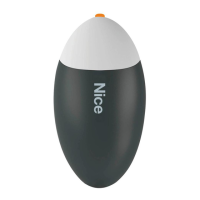USER MANUAL (to be delivered to the end user)
STEP 16
This user guide should be stored and handed to all users
of the automation.
16.1 – WARNINGS
• Keep at a safe distance from the moving door until it is
completely open or closed; do not transit through the
door until it is completely open and has come to a stand-
still.
• Do not let children play near the door or with its com-
mands.
• Keep the transmitters away from children.
• Suspend the use of the automation immediately as soon
as you notice something abnormal in the operation (nois-
es or jolting movements); failure to follow this warning
may cause serious danger and accidents.
• Do not touch moving parts.
• Regular maintenance checks must be carried out by
qualified personnel according to the maintenance plan.
• Maintenance or repairs must only be carried out by quali-
fied technical personnel.
• Send a command with the safety devices disabled:
Ifthesafetydevicesdonotworkproperlyorareoutoforder,the
doorcanstillbeoperated.
01.Commandthedoorwiththetransmitter.Ifthesafetydevices
givetheenablesignal,thedooropensnormally;otherwise,reat-
temptwithin3secondsandkeepthecontrolactivated.02. After
approximately2secondsthedoorwillstartmovinginthe“man
present”mode,thatis,solongasthecontroliskeptactivated
thedoorwillkeepmoving;assoonasthecontrolisreleasedthe
doorwillstop.
Ifthesafetydevicesareoutoforder,arrangetorepairtheauto-
mationassoonaspossible.
16.2 – Manually
releasing and locking the gearmotor
Thegearmotorisequippedwithamechanicalsystemthatallows
foropeningandclosingthedoormanually.
Manualoperationmustbeperformedinthecaseofapowerout-
ageorintheeventofanomaliesaffectingthesystem.
1 Pullthereleasecorddownuntil
youhearthecarriagebeingrelea-
sed.
2Thedoorcannowbemoved
manually.
The activation of the manual
release may cause an uncon-
trollable movement of the door
if the springs are weak or bro-
ken, or if the door is off-balance.
Torestorethefunctionalityoftheautomationsystem,movethe
doorbackinpositionuntilyouhearthecarriagebeingenga-
ged.
Intheeventofagearmotorfault,itisstillpossibletotryrelease
themotortocheckwhetherthefaultliesinthereleasemecha-
nism.
16.3 – User-admissible maintenance operations
Theoperationsthattheusermustcarryoutperiodicallyarelisted
below:
• Cleaning of the surfaces of the devices: use a slightly
damp (not wet) cloth. Do not use substances containing
alcohol, benzene, thinners or other flammable substanc-
es; the use of these substances may damage the devices
and cause fires or electric shocks.
• Removal of leaves and stones: disconnect the power
supply before proceeding, so as to prevent anyone from
moving the door.
16.4 – Replacing the transmitter battery
Whenthebatteryisflat,thetransmittercapacityissignificantly
reduced.If,whenabuttonispressed,therelevantLedturnson
thenimmediatelyfadesandturnsoff,itmeansthatthebatteryis
completelyflatandshouldbeimmediatelyreplaced.
IfinsteadtheLedturnsononlyforamoment,itmeansthatthe
batteryispartiallyflat;thebuttonmustbekeptpressedforat
leasthalfasecondforthetransmittertoattempttosendthe
command.
However,ifthebatterylevelistoolowtocompletethecommand
(andpossiblywaitfortheresponse),thetransmitterwillturnoff
andtherelevantLedwillfade.Inthesecases,normaltransmitter
operationcanberestoredbyreplacingthebatterywithanother
ofthesametype,whileobservingtherelevantpolarity.Toreplace
thebattery,proceedasshownbelow.
a b
c d
Batteries contain polluting substances: do not dispose
of them together with common waste but use the methods
set forth in the local regulations.
English–27
English

